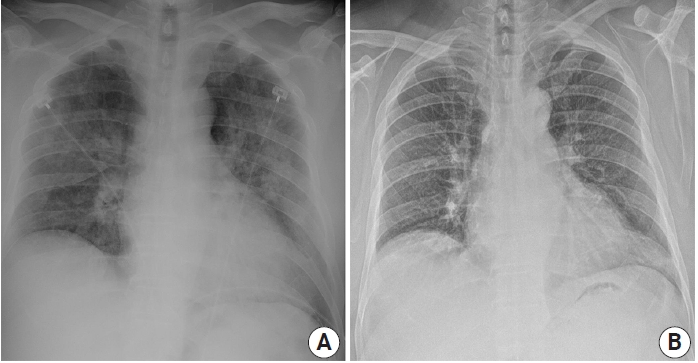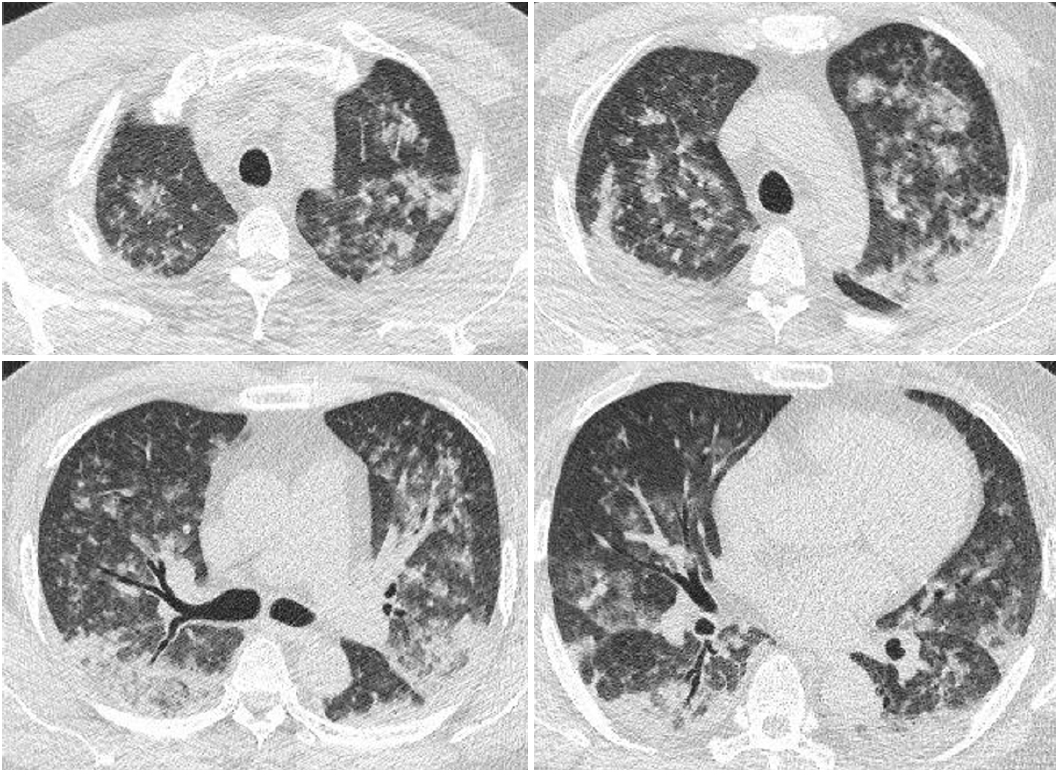Articles
- Page Path
- HOME > Acute Crit Care > Volume 36(4); 2021 > Article
-
Images in critical care
Pulmonary Acute lung injury following occupational exposure to nitric acid -
Ji Hoon Jang1
 , Sung Yeon Hwang2
, Sung Yeon Hwang2 , Chi Ryang Chung1,3
, Chi Ryang Chung1,3 , Gee Young Suh1,4
, Gee Young Suh1,4 , Ryoung-Eun Ko1
, Ryoung-Eun Ko1
-
Acute and Critical Care 2021;36(4):395-396.
DOI: https://doi.org/10.4266/acc.2021.01557
Published online: November 26, 2021
1Department of Critical Care Medicine, Department of Medicine, Samsung Medical Center, Sungkyunkwan University School of Medicine, Seoul, Korea
2Department of Emergency Medicine, Department of Medicine, Samsung Medical Center, Sungkyunkwan University School of Medicine, Seoul, Korea
3Department of Medicine, Department of Medicine, Samsung Medical Center, Sungkyunkwan University School of Medicine, Seoul, Korea
4Division of Pulmonary and Critical Care Medicine, Department of Medicine, Samsung Medical Center, Sungkyunkwan University School of Medicine, Seoul, Korea
- Corresponding author: Ryoung-Eun Ko Department of Critical Care Medicine, Samsung Medical Center, Sungkyunkwan University School of Medicine, 81 Irwon-ro, Gangnam-gu, Seoul 06351, Korea Tel: +82-2-3410-3429, Fax: +82-2-3410-6956, E-mail: ryoungeun.ko@samsung.com
Copyright © 2021 The Korean Society of Critical Care Medicine
This is an Open Access article distributed under the terms of the Creative Commons Attribution Non-Commercial License (http://creativecommons.org/licenses/by-nc/4.0/) which permits unrestricted non-commercial use, distribution, and reproduction in any medium, provided the original work is properly cited.
-
CONFLICT OF INTEREST
No potential conflict of interest relevant to this article was reported.
-
AUTHOR CONTRIBUTIONS
Conceptualization: JHJ, REK. Data curation: JHJ, REK. Visualization: JHJ. Writing–original draft: JHJ, REK. Writing–review & editing: all authors.
NOTES


- 1. Persinger RL, Poynter ME, Ckless K, Janssen-Heininger YM. Molecular mechanisms of nitrogen dioxide induced epithelial injury in the lung. Mol Cell Biochem 2002;234-235:71-80.ArticlePubMed
- 2. Hajela R, Janigan DT, Landrigan PL, Boudreau SF, Sebastian S. Fatal pulmonary edema due to nitric acid fume inhalation in three pulp-mill workers. Chest 1990;97:487-9.ArticlePubMed
- 3. Kao SL, Yap ES, Khoo SM, Lim TK, Mukhopadhyay A, Teo ST. Acute lung injury after inhalation of nitric acid. Eur J Emerg Med 2008;15:348-50.ArticlePubMed
References
Figure & Data
References
Citations

- Treatment with sivelestat sodium of acute respiratory distress syndrome induced by chemical pneumonitis: A report of three cases
Liang Jing, Xi Peng, Dayong Li, Yusen Qin, Yaqin Song, Wei Zhu
Experimental and Therapeutic Medicine.2023;[Epub] CrossRef

 KSCCM
KSCCM
 PubReader
PubReader ePub Link
ePub Link Cite
Cite



